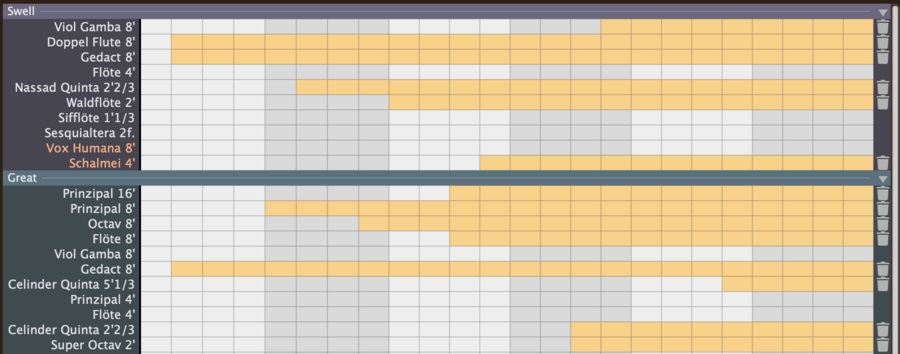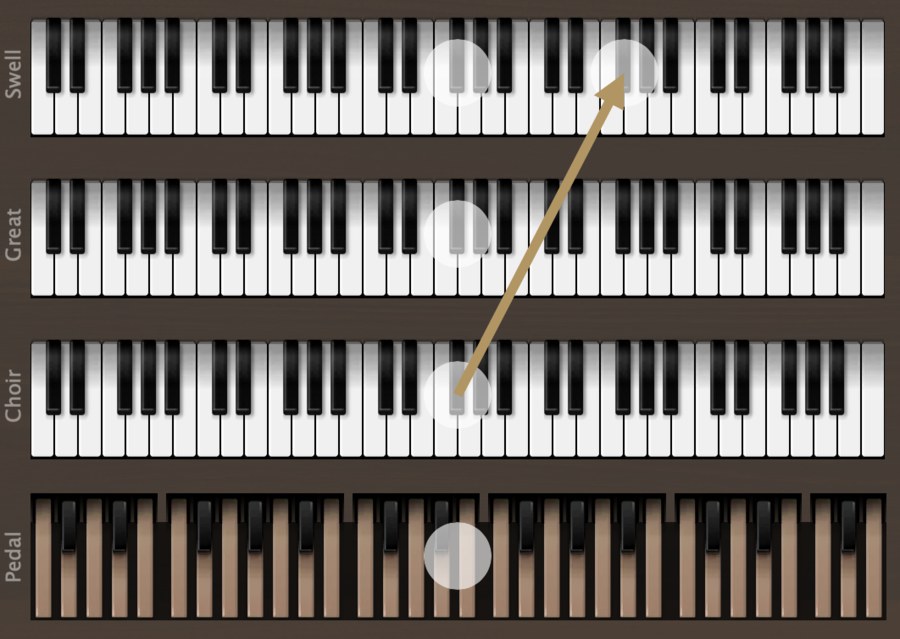Organteq features
Organteq offers over four thousand pipes, inspired from many great organ builders of French Romantic and German Baroque periods : A. Cavaillé-Coll, G. Silbermann, T. Tröst and many others.
These 68 organ stops, ranging from 32' to 1', can be assigned to three manual keyboards with a five-octave range, and a pedal keyboard with thirty-two notes.
Every pipe of every stop can be voiced to your taste through many user parameters.
Physical modelling
The core synthesis algorithms of Organteq are based on aeroacoustics of the organ pipes. The equations of the air jet growing and impacting the labium, the equations of the beating reed, as well as the ones that describe the pipes resonances, are used to synthetize organ pipe sounds.
In addition, the acoustics radiation from the pipes ends to the division box first, and then to the main space. This makes it possible to listen to the organ sounds in various configurations.
Organteq Console
a main view....
with octave-transposition options
perfect for the user who do not have pedalboard or MIDI organ console
to create and store your organ sounds palette

... and alternative views
Organteq also offers alternative console views (or "Jamb Views") that gathers all your organ informations and controls in a condensed way.
The Jamb Views are touch screen compatible, detachable, and let you activate multiple stops within a single drag.

A dual-split option for multiple screens is also offered.


A broad and diverse collection of 56 organs
You will find among the 56 Organteq presets some archetypal organs carefully designed and voiced to represent at best the French Romantic and German Baroque organ building traditions - from small and intimate Romantic choir organs to the roaring and powerful Baroque cathedral instrument. Every archetypal organ also comes with many variations : more or less detuned, listening from the organ console or from the audience point of view.
Organteq also comes with 24 historical and modern organs of diverse aesthetics and periods, ranging from early Classical era to the Neo-Baroque movement of the XXth century. These thoroughly crafted instruments provide a broad selection of styles and sounds to explore, passing through the mighty Versailles Chapel organ and other ones made by famous builders such as A. Schnitger, Dom Bedos, Cavaillé-Coll and many more...
An exhaustive description of all 56 presets can be found here.
Tweak your organ
design every detail of the console and its stops
From the powerful 32' bass pipes to some soft-voiced flue pipes, roaring reeds and exciting mixtures, 68 carefully crafted organ stops are assignable to any of the console 50 stop slots.
Build and modify your organ composition easily with a smooth and streamlined GUI (copy/paste/swap/move/insert, ...).

Stop voicing
Voice and harmonize each stop to your taste ... and even individual pipes!
Tweak the parameters of the physical model and adjust the brightness, wind jitter, chiff - and more! - according to your needs and tastes!

Expression pedals
Expression pedals controls the opening of wooden boxes in which organ pipes are enclosed.
Organteq offers 3 configurable expression pedals : each one of them can be easily assigned to one or several keyboard divisions, but also to a selection of individual stops.
Tweak and modify each pedal effect with filter shapes for closed and open pedal position.

Tremulants
Tremulants are a mechanical device that modulate the upstream air flow that feeds the organ pipes. These modulations affect the pitch, intensity and spectral content of the sound... and are generated by the physical model itself - not by a post-processing audio effect!
Organteq lets you assign and customize 4 different tremulants: choose which keyboards and stops that should be affected by each tremulant, and adjust their amount, rate, and shape.

Crescendo pedal
The Crescendo pedal triggers a sequence of stops switches, but also coupler and tremulants to help you create great dynamic playing.
It has 24 fully configurable steps. Its configuration is smooth and straightforward thanks to the streamlined GUI and its detachable window.

Couplers
Couplers let you play simultaneously the pipes of one division from an alternative manual.
Organteq proposes 6 customizable couplers, with octave transpositions options. Octave and sub-octave couplers within a single keyboard are also possible.

Monophonic Couplers
Monophonic couplers are an exciting and new feature that send only the bass line or the melody played on one keyboard to another. The monophonic couplers behaviour is carefully designed to offer a stunning playability and to provide exciting registration possibilities!

Combinations and Banks
Create and store your organ sounds palette with 100 banks of 10 combinations each. Easy snapshots from the main UI. Optimised management of banks and combinations for a smooth and controlled performance.

Division Box settings
In real organs, each keyboard is associated to a division and all the pipes of a division are enclosed in a single wooden box. Of course, these wooden boxes have some acoustical effects and influence the sound of the organ.
Organteq allows you to control these effects : for each division, you can tune its gain, its associated EQ, the size of the division box and its presence in the final mix.

Output settings
Play with the sound space : adjust the stereo width and the C/C# spatial separation of organ pipes.
A new routing audio output matrix of up to 8 channels.

Reverb
The Reverberation plays a huge role in the «organ sound» : the space in which the organ is placed (a cathedral or a much smaller room) is also part of the instrument!
- Many built-in presets of reverberations
- mix, duration, dimension, pre-delay...
- load external WAV impulse response

Standalone or Plug-in
Organteq 2 is available for macOS (10.7 or later), Windows (7 or later) and Linux (x86 & ARM),
both as a standalone instrument and as a 64-bit plug-in for VST, AAX and AudioUnits hosts.





